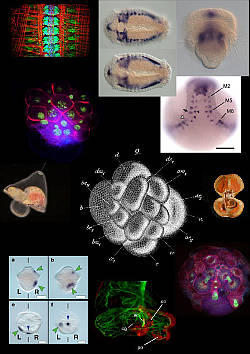SICB Annual Meeting 2010
January 3-7, 2010
Seattle, WA
Symposium: Spiralian development: Conservation and innovation
 Spiralian development is the dominant mode of early development among a large group of protostomes phyla called the Lophotrochozoa. This clade includes roughly a third of the animal phyla and exhibits the highest degree of animal body plan diversity among the three superclades of bilaterian animals. Spiralian development is characterized by 1) a stereotyped pattern of early asymmetric cell division called spiral cleavage, 2) similarities in the pattern of cell fates in the blastula, and 3) similarities in larval morphology.
Spiralian development is the dominant mode of early development among a large group of protostomes phyla called the Lophotrochozoa. This clade includes roughly a third of the animal phyla and exhibits the highest degree of animal body plan diversity among the three superclades of bilaterian animals. Spiralian development is characterized by 1) a stereotyped pattern of early asymmetric cell division called spiral cleavage, 2) similarities in the pattern of cell fates in the blastula, and 3) similarities in larval morphology.
Recent phylogenetic studies indicate that the common ancestor of the Lophotrochozoa had spiralian development, highlighting the importance of this character for understanding the evolutionary history of animal diversification and animal development. There are also particular advantages for studies of the evolution of development within the spiralians. The strong conservation of spiralian development means that homology can be recognized at the level of individual cells in the embryos of distantly related phyla, and many aspects of the common ancestor of spiralians can be reliably predicted. Against this backdrop of conservation, there is a wealth of evolutionary novelty, both subtle and dramatic.
This symposium is sponsored by:
DDCB and DEDB (SICB)

Emacs!
Objectives
The major goal of this symposium is to foster communication among groups that are working on the developmental biology of members of the clade Lophotrochozoa (=Spiralia). We intend to define core spiralian developmental mechanisms, and identify elaborations and modifications of these conserved mechanisms. Given the significant changes in the field in the last few years, including new functional methods, improved phylogenetic resolution, and genomic data, this meeting is expected to transform understanding of this important character set, and generate new questions and collaborations.
Organized by: J. David Lambert, University of Rochester and Elaine Seaver, University of Hawaii
Preliminary Schedule

